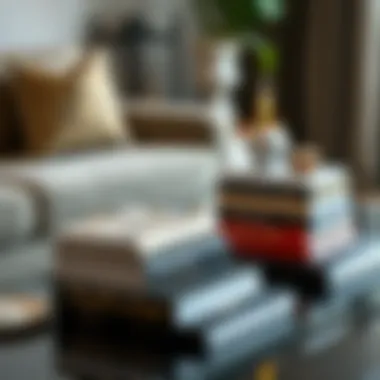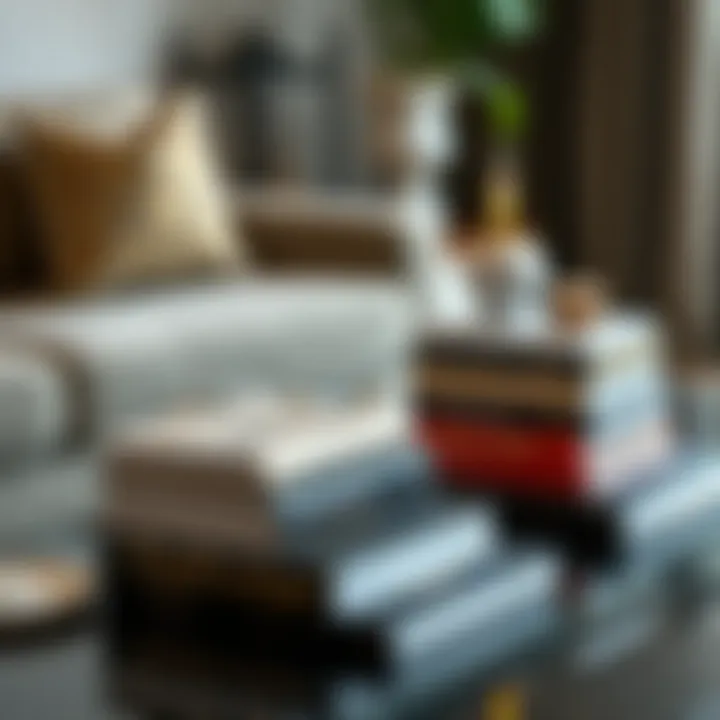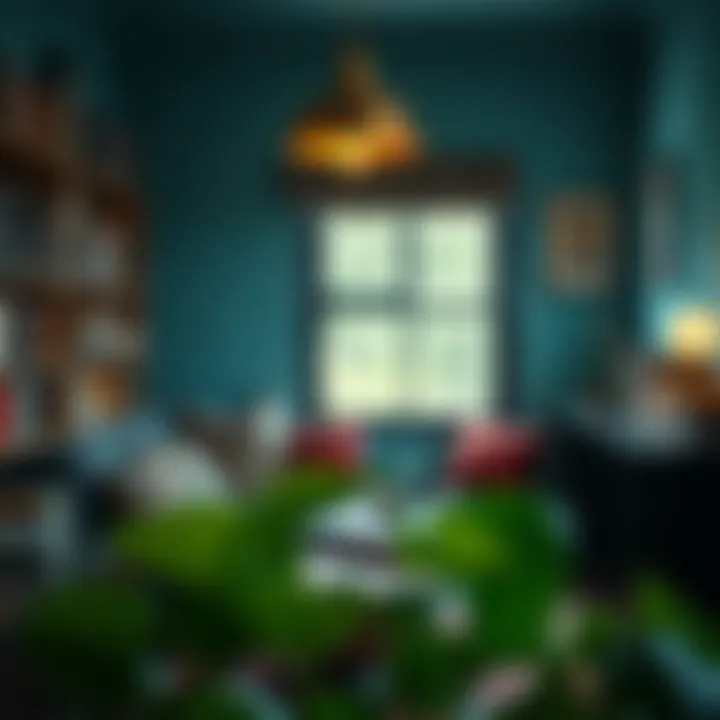The Aesthetic Role of Books in Interior Design


Intro
Books are typically seen as vessels of knowledge or stories waiting to be told. However, when one steps back to look at the broader picture, these bound collections of pages hold a different kind of magic. They can be stylish accents and conversation starters, shaping the atmosphere of a room far beyond their written content. This article delves into the aesthetic function of books in interior design, unraveling their role as more than just reading materials.
In a world increasingly dominated by digital media, tangible objects like books breathe life into spaces. How a room feels, resonates, and even inspires can hinge upon these decorative pieces, their covers, and their placement. The unity of genres, colors, and textures can alter our perception of space, and understanding this can lead to a more profound appreciation of not only the written word itself but also its surroundings.
This exploration covers the diverse genres of decorative books, their visual contributions to design, and how they complement different styles and themes. Furthermore, as sustainability grows in prominence, there is also an urgent need for strategies that ensure our decorative collections are not just visually pleasing but responsibly curated. In showcasing books that represent personal taste yet also enhance the overall ambiance, we can create immersive environments that tell a story beyond their spines.
As we embark on this journey in appreciation of the aesthetic function of books, we’ll get into:
- The significance of book genres in decor
- Tips to curate a collection that reflects sustainability
- The fusion of design themes with literary aesthetics
In a nutshell, we’re not just talking about books but the experience and poetry they bring into our lives and spaces.
The Intersection of Literature and Interior Design
Books have been a part of human culture for centuries. Their significance extends beyond the pages printed within them. In this article, we delve into how these printed works play a pivotal role in interior design, shaping both aesthetics and environments. When we think of literature, it often evokes thoughts of quiet reading nooks or study corners. However, books serve as far more than just vessels of knowledge. They can be central to enriching our living spaces, elevating them in terms of style, character, and even symbolism.
Incorporating books as decorative elements can enhance a room's visual depth and intrigue. This intersection of literature and interior design introduces a harmonious relationship where stories and visual appeal coalesce. A cozy living room adorned with a collection of beautifully bound novels or a sleek office space featuring artistic coffee table books instantly conveys personality and reflects the homeowner's interests.
Benefits of Integrating Books Into Interior Design
- Visual Focal Points: Bookshelves create an immediate focal point in a room, drawing the eye and making a statement about taste and intellect.
- Color Harmony: The covers of books provide a spectrum of colors that can be coordinated with wall tones, furniture, and accessories, allowing for cohesive design.
- Cultural Significance: Decor that includes books signals a respect for knowledge and culture, showcasing one's appreciation for literature and learning.
- Personal Touch: Decorative books allow individuals to express personal identity. The choice of what to display can reflect passions, interests, and values.
- Enhancing Ambiance: The overall atmosphere can change dramatically with the inclusion of books, affecting mood and inviting conversation.
By recognizing this shared space between literature and design, we can appreciate the layers of meaning and connection that books add to our environments. It’s not just about placing a few volumes on a shelf; it’s about curating spaces that resonate.
Aesthetics of Books as Decor
When viewed through the lens of home decor, books offer textures and shapes that can vastly differ from other elements. A hardback novel with a crisp, textured cover can contrast sharply with the smooth surfaces of modern furniture. Moreover, they can breathe life into stagnant interiors.
Consider a well-styled bookshelf. It’s not just a storage unit, but an artistic arrangement, where the vertical lines of books juxtapose beautifully against horizontal shelves. Displaying books in various orientations—some standing upright, others laid flat—encourages movement within the visual design, guiding the viewer’s gaze across the collection. This interplay of form and function creates a dynamic space, where each detail contributes to a curated aesthetic.
Key Aspects of Book Aesthetics
- Varied Sizes and Shapes: Diverse book dimensions bring visual interest and can sculpt the flow of a room. Large coffee table books can anchor a table while smaller volumes can fit into nooks and crannies.
- Cover Designs: Beautifully designed book covers, whether they are vintage or modern, can serve as art pieces. They can be used intentionally to match a theme or color scheme.
- Texture and Materiality: The tactile nature of books adds depth. Leather-bound editions evoke a sense of history and luxury, while contemporary paperbacks offer a clean, casual appeal.
By thoughtfully considering the role of aesthetic choices in book selection, individuals can create a sophisticated and inviting atmosphere that invites admiration and engagement.
Symbolism in Decorative Choices
Books symbolize knowledge, adventure, and personality. When used decoratively, they can convey profound narratives that go beyond the words printed on their pages. The selection of books can express one’s identity and values, showcasing what one cherishes in life.
Meaning Behind Book Selections
- Genres as Reflections: A choice of literature can signify interests; for instance, displaying works from literary greats may indicate a valuing of classic literature, while a collection of travel guides showcases a love for exploration.
- Personal Narratives: A well-curated stack of books can tell a story about one’s journey—each book a chapter representing different phases in life.
- Cultural and Historical Context: Specific titles may symbolize heritage and background, allowing individuals to declare and embrace their cultural identity openly.
Incorporating books into interior design provides not only aesthetic appeal but also richer narratives that enhance personal spaces. As readers curate collections, they essentially build layers of meaning through decorative choices, transforming homes into reflections of their life stories.
Understanding Decorative Books
Understanding decorative books is central to grasping their role in enhancing the aesthetic appeal of living spaces. These books do more than just share stories; they contribute to the overall atmosphere and style of a room. When chosen thoughtfully, each book can act as a conversation piece, adding layers of meaning and charm to a setting. This section will explore various genres of books that enrich design, detailing how their specific characteristics lend themselves to decorative purposes.
Genres that Enhance Design
When it comes to selecting books that serve as decorative elements, it's crucial to consider the genre. The right genre not only complements the existing decor but also provides insights into personal tastes and values. Here are a few genres that can significantly improve interior design:
Art and Coffee Table Books
Art and coffee table books are the epitome of decorative literature. These volumes often have striking visuals and minimal text, making them ideal for display. They can introduce colors and themes that resonate with the rest of the room's design. A key characteristic of this genre is its visual appeal; each page can inspire creativity or provoke thought. This makes it a popular choice among decorators who aim to craft a visually rewarding environment.
Advantages: Art books can act as both a decorative object and a visual narrative. Their unique designs can make a room feel more cultured and inviting.
Disadvantages: However, not all art books are created equal. Some might be too niche or specific, limiting their broader appeal. It's essential that the selected pieces align with the intended audience and emotional tone of the space.


Fashion Literature
Fashion literature brings a unique flair to interior spaces. Often filled with stunning photography and insightful commentary, these books serve as a gateway into the world of style and trends. The intrinsic value of fashion literature lies in its ability to spark inspiration and discussion about current or past styles.
One key characteristic of fashion literature is its focus on iconic designers and eras. This genre not only reflects individual taste but also evokes memories and aspirations surrounding fashion. With ever-evolving trends, having a curated selection of fashion-related titles can serve as a timely reminder of one's aspirations in style.
Advantages: They can inject a sense of glamour and prestige to a room, making them particularly appealing to those who cherish aesthetic sophistication.
Disadvantages: On the downside, fashion books can rapidly become outdated as trends shift. Thoughtful curation is necessary to maintain their relevance and impact.
Travel Anthologies
Travel anthologies are not only a source of knowledge about distant cultures but also a means of decorating with purpose. These books can vividly transport the reader to various parts of the world through stunning visuals and narratives, augmenting the aesthetic experience within a space.
A key aspect of travel anthologies is their ability to tell stories, sharing experiences and escapades from different locales. This adds depth to their decorative value, encouraging discussions and reflections about one's own travel experiences or future aspirations.
Advantages: They allow for personal expression and narrative creation within the design. A well-placed travel anthology can also inspire wanderlust in anyone who lays eyes on it.
Disadvantages: However, if not aligned with the room's theme, these anthologies can feel out of place. Choosing the right titles that harmonize with existing decor is paramount.
The Role of Color and Texture
The color and texture of decorative books play a significant role in their overall effectiveness as design elements. Books can introduce new hues to a space or complement existing color schemes, becoming a seamless part of the interior design process. Textures, on the other hand, add depth and tactile interest, inviting interaction. By understanding these elements, one can further enhance the aesthetic function of decorative books.
Curation Techniques for Decorative Books
Curation techniques for decorative books form the backbone of any aesthetically pleasing interior where literature plays a significant role. It's not just about having books on display; it's about choosing and arranging them in ways that enhance the overall environment. With literature being a versatile decorative element, employing the right curation techniques can transform a mundane space into a cozy nook or a vibrant focal point. It's all about making purposeful decisions to reflect a personal style while also considering the functional aspects of design.
Creating a Thematic Collection
Color Coordination
Color coordination is a crucial aspect of creating a cohesive look with decorative books. By considering the hues and shades of the book covers, one can create a harmonious palette that ties the room together. For instance, if the room features warm tones like beige and terracotta, a collection of books with similar warm hues can dramatically enhance the space's comfort levels. One key characteristic of color coordination is its ability to evoke emotions; warm colors often instill feelings of warmth and welcome, while cooler tones may invoke calmness.
The advantage of color coordination lies in its straightforwardness. It allows for a visually appealing arrangement without necessarily needing in-depth knowledge of design principles. However, one should be cautious; sticking strictly to one color scheme might limit creativity and overlook unique designs that contribute to the overall aesthetic.
Subject Matter Alignment
Subject matter alignment focuses on grouping books by their themes or topics. This method not only allows for organized displays but also instills a sense of narrative within the space. For example, a collection of travel literature can transport viewers to distant lands just by glancing at the shelves. A key characteristic of subject matter alignment is its storytelling capability; it sparks conversations and invites curiosity.
Choosing books based on subject matter can double as a form of self-expression, showcasing interests and passions. However, noteworthy is that balancing diverse subjects might create a visual cacophony if not done carefully. Therefore, it's essential to strike a balance to maintain visual harmony while still embracing diverse literary tastes.
Displaying Books for Maximum Impact
Shelving Techniques
The way books are shelved is an integral aspect of their impact on the room's aesthetics. Different shelving techniques can create varied atmospheres. For example, using open shelves provides easy access and a more casual look, while closed cabinets might lend a more formal air. One must consider the versatility of shelving options, which can include floating shelves, built-ins, or decorative bookcases.
The unique feature of shelving techniques lies in how they dictate the flow of a space. For instance, floor-to-ceiling shelves can create an illusion of height, making a small room appear larger. However, heavy shelving can also seem overwhelming in a minimalist space; thus, choosing the right shelving style according to the overall design is paramount.
Styling with Accessories
Styling with accessories adds the finishing touch to displayed books, elevating the overall look while also reflecting personal taste. Think of using elegant bookends, decorative trays, or plants to enhance the visual appeal. This approach not only complements the books themselves but also allows for unique combinations that tell a story.
Adopting this technique means embracing a layered look that brings various elements together, creating a well-rounded design. The benefit lies in its ability to highlight the books while integrating other aesthetic aspects of the room. That said, over-styling can lead to cluttered effects, which detracts from the visual clarity that well-curated collections should ideally provide.
"The aesthetic function of books is not just found in the reading; it’s found in their ability to weave personalities into the fabric of our living spaces."
Through careful consideration of color, subject matter, shelving, and accessories, anyone can enhance the aesthetic function of books, creating spaces that are both visually pleasing and personally significant.
The Influence of Design Styles on Book Selection
Books do not simply offer a window into stories or knowledge; they can also serve as pivotal elements in the visual scheme of an interior space. The selection of decorative literature is greatly influenced by the overall design style of the room, from mid-century modern to rustic farmhouse. Understanding how different styles impact book choice can enhance the aesthetic value of any environment. Each design style has its set of characteristics, and choosing books that resonate with these traits can create a harmonious atmosphere.
Modern vs. Classic Aesthetics


When considering modern versus classic aesthetics, the differences are like night and day. Modern design often emphasizes minimalism—clean lines, open spaces, and an overall crispness. Books in this context might be selected for their monochromatic covers or minimalist designs. Instead of displaying a varied collection, one might choose a limited palette, perhaps whites and blacks or muted pastels, to tie seamlessly into the space. This can create a cohesive look that feels fresh and sophisticated.
Conversely, classic aesthetics thrive on richness and depth. Rather than simplicity, you might find ornate bindings, heavy tomes with gilded edges, or colorful covers that tell a story even before you crack them open. In a traditionally-furnished sitting room, books can become history’s narrators; their rich colors and textures add warmth, speaking of erudition and refinement. The duality of choosing books that align with these aesthetics demonstrates not just a preference, but an understanding of the overall visual and tactile narrative being constructed within a space.
Eclectic Interiors and Book Choices
Eclectic design truly embodies the phrase "one person’s trash is another person’s treasure." It allows for a free-flowing combination of various styles, colors, and textures—a kind of visual jazz. Here, the selection of books reflects this very nuance. A well-selected library in an eclectic space might include anything from brightly illustrated art books to delicate poetry anthologies. The focus here isn’t just on cohesion but on the delightful disarray of personality and uniqueness.
Books can become a conversation starter, a quirky accent piece that grabs attention. This allows for the inclusion of unconventional bindings, bold colors, and various genres that reflect a personal style. Whether it’s travelogues adorned with gorgeous photography or vintage novels with retro covers, every choice can add to the rich tapestry of the room. In an eclectic interior, the impact of books transcends their original purpose and becomes a vital thread in the style's colorful narrative.
"In the world of decor, books are the unwritten rules that guide a design style."
By recognizing the influence of design styles on book selection, one can curate a collection that not only showcases a love for literature but also enhances the overall aesthetic experience of any space. The right book in the right place can transform a room from merely functional to a storytelling haven, reflecting taste, personality, and an appreciation for both art and literature.
Sustainability in Decorative Book Practices
Sustainability in decorative book practices has become a prevailing theme in the realm of interior design, showing that books can serve as not just decoration but as ethical choices. As awareness grows regarding environmental issues, the implications of sourcing and displaying literature need careful consideration. Understanding how to select and present books with sustainability in mind does not just cater to the growing market; it champions responsible consumption that resonates deeply with a conscientious readership.
The importance of sustainability in this context extends beyond aesthetics. It embodies a commitment to preserving resources, promoting a circular economy, and fostering a deeper connection between individuals and their objects. Each book can carry stories, histories, and cultural significance, so it's crucial to approach decorative practices with this understanding in mind.
Ethical Sourcing of Decorative Literature
When we consider the ethics behind curation, the sourcing of decorative literature plays a significant role. Opting for books from publishers that prioritize sustainable practices contributes to reducing our ecological footprint. For instance, many publishers now utilize recycled paper or support forest-friendly initiatives that align with eco-conscious values. Choosing these books demonstrates awareness of not just the immediate surroundings but also the broader impact on the planet.
Furthermore, second-hand stores and local flea markets often offer hidden gems. This practice not only reduces waste but also gives new life to material that has already served its purpose. By choosing to incorporate used books into decor, we are not only saving items from possible fate as waste, but we are also embracing stories from the past—a subtle blend of culture and sustainability.
"Buying one of these vintage books is like adopting a piece of history," a local bookstore owner remarked. This highlights how ethical sourcing transcends mere purchasing; it's about the stories and journeys that books carry through time.
Repurposing and Upcycling Literature
Repurposing and upcycling literature is another avenue that emphasizes sustainability in decorative practices. Instead of allowing books to sit idly on shelves, creative applications can breathe new life into them. This not only maximizes the functionality of the books themselves but also transforms them into unique art pieces.
For example, old books can find new roles as decorative centerpieces or art installations. From transformed book sculptures to wall art made from pages, the possibilities are endless. Additionally, decorative DIY projects can use book spines to create bespoke shelving or design quirky book nooks, showcasing literature while aiding in efficient use of space.
Another method involves crafting items like bookmarks or coasters from lesser-known or damaged books, which might otherwise end up neglected and forgotten. This approach emphasizes creative thought and ingenuity, allowing individuals to reflect their personality through their decor while making a sustainable choice.
The Psychological Effect of Books in Living Spaces
The presence of books in living spaces is less about mere decor and more about the message it sends to both residents and visitors. Books can create a sense of comfort, bridging a gap between aesthetics and psychological comfort. This overlay of physical literature can affect mood, spark nostalgia, and promote an inviting atmosphere. When arranged thoughtfully, they can transform a cold room into a warm environment, contributing significantly to the psychological well-being of those who dwell within.
Creating a Library-like Atmosphere
Designing a library-like atmosphere at home transcends simply stacking books on shelves. It involves creating a sanctuary of knowledge and comfort where individuals feel inspired. To achieve this, consider the following elements:
- Lighting: Soft, warm lighting can mimic the ambiance of a cozy library. Opt for floor lamps with a vintage feel or wall-mounted reading lights to illuminate both the books and the space.
- Comfortable Seating: Invest in plush chairs or a deep sofa. This encourages not only reading but also deeper conversations and reflection as people gather in the living space.
- Visual Hierarchy: Arrange books not just by genre or color but also in a way that creates visual interest. Stacking some horizontally and arranging others vertically can provide a dynamic and inviting view.
- Art and Decor: Integrate art pieces or decorative items that resonate with the themes of your book collection. This creates a cohesive look and enhances the library feel.
Ultimately, the goal is to foster a comfortable environment where the presence of books invites engagement and exploration.
Books as a Reflection of Personal Identity
Books can serve as a personal manifesto, silently proclaiming an individual's tastes and values. The titles one chooses to display often reflect not only their interests but also their aspirations and perceptions of self. For instance:
- Diverse Genres: A collection that encompasses various genres can signal open-mindedness and a thirst for knowledge. It suggests that the individual is engaged with the world, eager to learn from different perspectives.
- Aesthetic Choices: The physical characteristics of a book—like its cover art, binding, and even size—speak volumes about one’s style preferences. A well-curated selection can elevate the overall design of the space and convey a sophisticated aesthetic.
- Personal Narratives: Each title may have a story attached to it—be it a life-changing read during college, a childhood favorite, or even a family heirloom. These books inevitably tell a story about who the person is and where they come from.
“Books are a uniquely portable magic.” — Stephen King
For more tips on designing intimate spaces, you might find resources on platforms such as Wikipedia or Britannica.
In crafting a truly unique space, consider both your taste and the stories you wish to tell through your collection. Incorporating the right elements not only enhances the physical space but also fosters a deeper connection to literature and, by extension, to oneself.
Practical Considerations when Choosing Decorative Books
Choosing decorative books for any space isn't just a matter of grabbing a few pretty covers off the shelf. It involves a thoughtful approach where aesthetics, personal taste, and the function of the books interact harmoniously. The practical considerations surrounding this selection process can determine the success of the decorative display, ensuring that books don't just sit pretty but also enhance the overall environment.
Balancing Function and Aesthetics


When it comes to balancing function and aesthetics, it’s about selecting books that appeal visually while also serving a purpose. Take for example a living room. You might want a coffee table that attracts attention, and decorative books act as conversation starters. However, those books should resonate with the theme of the room and the lifestyle of its occupants. Selecting vibrant art books, travel journals, or even vintage classics can create a striking visual impact without needing to compromise on the utility they offer as reading material.
- Visual Cohesion: Ensure that the colors and sizes of the books align with the existing color palette and design themes of the room.
- Practical Accessibility: Consider how easily accessible these decorative books are for guests. If they spark interest but are immediately shoved into a back corner, they might lose their charm.
"A well-placed book can do wonders for an interior; it bears stories that connect people beyond mere sight."
By thoughtfully integrating both visual appeal and functional aspects, one facilitates a harmonious blend that speaks to both aesthetics and usability.
Maintaining the Integrity of Decorative Books
Preserving the integrity of decorative books is crucial, not only from a historical or sentimental standpoint but also for the overall aesthetics of a space. There is merit in books that show character, but excessive wear can detract from their appeal. To keep those books in good condition, one might consider the following:
- Proper Shelving: Avoid overcrowding, which can lead to damage. Keeping books upright or propped to avoid bending will help maintain their shape and spine integrity.
- Avoid Direct Sunlight: Ultraviolet rays can fade colors and damage pages over time. Positioning books away from direct sunlight will protect their covers and preserve the vibrant hues that make them decorative.
- Cleaning and Care: Every now and again, gently dusting off surfaces keeps books looking their best. Utilize a soft cloth rather than heavy cleaners or solutions that could potentially stain or degrade materials.
Maintaining the integrity ensures not just the longevity of the books themselves but also enhances their aesthetic value in an ever-evolving decorative scheme.
Cultural Significance of Decorative Books
When it comes to interior design, books often take on a role much larger than just sitting pretty on a shelf. They are gateways to culture, history, and emotion. In this section, the focus is on the cultural significance of decorative books, exploring how they encapsulate collective narratives and personal stories.
Books serve as cultural artifacts. They not only reflect the zeitgeist of the time they were produced but also preserve the philosophies and artistry of different eras. A beautifully bound vintage volume may evoke a sense of nostalgia, pulling us back to a time when craftsmanship was revered. Titles that feature local authors or settings help culture thrive, all while fitting seamlessly into the aesthetic fabric of the room. Consider a richly illustrated book about local architecture placed on a coffee table; it's more than decor—it's a conversation starter that encapsulates local pride and history.
Books also become repositories of knowledge, art, and inspiration in any space. When decorative books are chosen thoughtfully, they can mirror the tastes and experiences of those who live among them. Here are some elements to consider:
- Historical Context: Each book carries its own background, adding depth to an interior's narrative.
- Cultural Currency: The choice of titles displayed tells guests about the homeowner's values and interests.
- Aesthetic Cohesion: Books can complement the color scheme, textures, and style of furniture, seamlessly tying the room together.
"Books are a uniquely portable magic." — Stephen King
By infusing a room with carefully selected decorative books, one creates an environment rich in meaning and significance.
Books as Cultural Artifacts
Books possess the unique ability to transcend time and space. As cultural artifacts, they encapsulate beliefs, practices, and the historical context of their creation. Rare editions or locally published works serve as tangible connections to a community's past, embodying the stories that shape its identity. Whether it's a first edition of a classic novel or a recent publication discussing contemporary issues, these books not only enhance visual appeal but also enrich the cultural tapestry of a space.
Moreover, the design of the book itself can be a work of art. Cover designs, typography, and illustrations often reflect the era of publication and can evoke a particular aesthetic. A collection of these artifacts on display can transform a mundane space into a gallery that sparks curiosity and conversation.
The Role of Literature in Heritage Preservation
Literature plays a vital role in preserving heritage. It captures the essence of cultural legacies that might otherwise fade into obscurity. Decorative books, especially those highlighting regional customs, trials, or triumphs, actively participate in keeping the flame of heritage alive.
Incorporating books that focus on a specific culture or heritage into interior design serves more than just an aesthetic purpose; it fosters awareness and appreciation. For instance, a beautifully illustrated book about indigenous art not only embellishes one's decor but also elevates a visitor's understanding of that culture. It’s the art of storytelling through decoration.
- Promotes Understanding: Books that explore different cultural perspectives encourage broadening of worldviews.
- Encourages Dialogue: They often invite conversations around topics that are crucial to society, strengthening community bonds.
- Fosters Appreciation of Diversity: Displaying diverse literature can celebrate the multifaceted nature of human experience.
In this way, decorative literature emerges as a powerful tool that sits at the intersection of aesthetics and cultural vitality—turning spaces into more than just places; they become realms of culture and identity.
Culmination: The Lasting Impact of Decorative Literature
The exploration of decorative literature reveals much more than just the physical presence of books in our living spaces. It delves into the hearts and minds of individuals, expressing personal identity and style through carefully curated collections. In examining the role of books as aesthetic elements, we recognize their potential to transform spaces and elevate interior design. Decorative books are not merely utilitarian; they serve as conduits of culture, creativity, and conversation.
Books as Symbols of Knowledge and Taste
When books are used for decoration, they symbolize a connection to knowledge and culture. They communicate to visitors that the owner values literacy, art, and history. In a world where everything moves at dizzying speeds, having a thoughtfully arranged book collection can encourage a slower, more reflective atmosphere. This can be particularly impactful in spaces like libraries, offices, or living rooms, where contemplation is welcome.
Benefits of Incorporating Decorative Literature
- Enhanced Aesthetic Appeal:
- Cultivating Intellectual Environment:
- Personal Reflection:
- Books can provide texture, color, and structure to a space, complementing furniture and décor.
- Their presence can create a stimulating environment that encourages learning and creativity, making them perfect for home offices and reading nooks.
- A collection of decorative books often reflects personal values, interests, and experiences, ultimately turning a house into a home.
Design Considerations
When selecting books for decoration, it’s vital to consider not just the titles, but also their hues, formats, and how they resonate with surrounding décor. Books of various sizes can create visual interest when stacked or placed on shelves. Likewise, color gradients can have a dramatic effect; soft pastels may create a calm aura, while bold hues can energize the room.
Books have the power to shape our experiences of space; they add depth to our lives and create dialogues that transcend words.
Future Trends in Decorative Literature
The ever-evolving nature of interior design indicates a shift towards sustainable and ethically sourced literature. With more consumers becoming conscious of their environmental footprints, there is a rising trend in repurposing old books and upcycling them for decorative purposes. This not only preserves literary history but also adds a unique charm to decor.
Moreover, as digital media continues to revolutionize reading habits, printed books are gaining newfound respect for their tactile experience. The tactile nature of books often compels individuals to rediscover the joy of reading physically crafted literature against the backdrop of their curated spaces.







